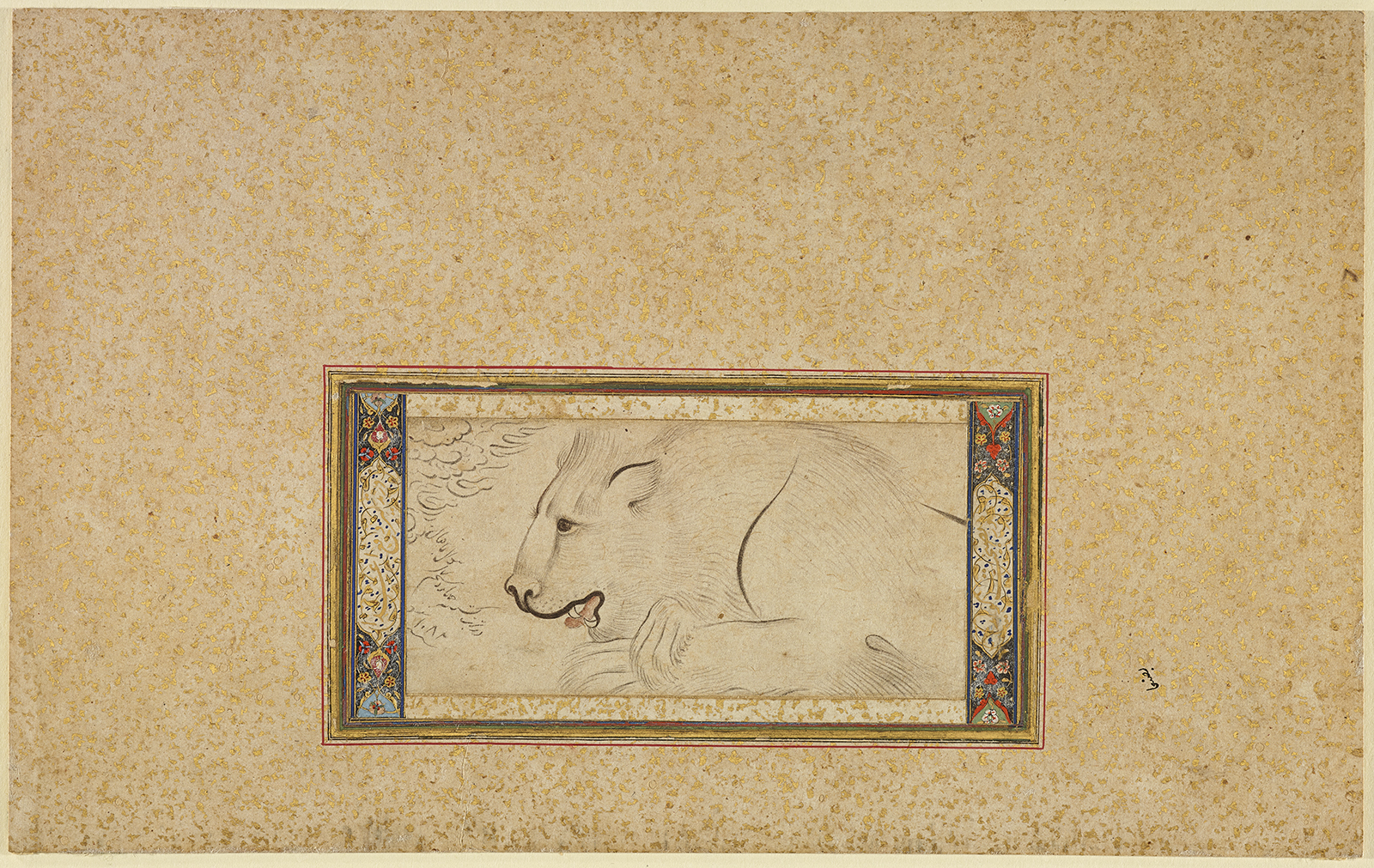Click on the image to zoom
A Resting Lion
- Accession Number:AKM111
- Creator:Attributed to Mo‘in Mosavvir
- Place:Isfahan, Iran
- Dimensions:14.1 x 22.5 cm
- Date:14 Shawwal 1082 (February 13, 1672)
- Materials and Technique:Ink, opaque watercolour, and gold on paper
This single-page drawing depicts a resting lion seemingly squeezed between two golden-lined and gold-flecked borders. Positioned beneath the Chinese clouds and directly in front of the lion (as if being exhaled from the lion’s open mouth), an inscription dates the drawing. Illuminated borders, probably later additions, flank the lion; featuring white-backgrounded cartouches with golden inscriptions, they are presumably taken from a clutch of cartouches. [1] A Resting Lion is attributed to artist Mu’in Musavvir, who was famous for his draftsmanship and for showing acute attention to detail in his drawings of animals. Trained by Reza-e ‘Abbasi, Mu’in Musavvir had a long career and carried Reza-e ‘Abbasi’s artistic ideas and new styles into the 18th century. Drawing wild and exotic animals was in no way unusual at that time, since Safavid rulers showed great interest in them. [2]
Further Reading
In the 17th century it became quite popular to sign and date drawings, especially when the demand for signed pages rose on the market. Reza-e ‘Abbasi and Mu’in Musavvir signed their drawings and often included additional details. There are two other drawings by Mu’in Musavvir dated from 1672; one kept in the Museum of Fine Arts in Boston shows a tiger attacking and mauling a boy who later died from his injuries. [3] Mu’in Musavvir had not seen this horrible attack himself, which was surely an item of discussion in Isfahan society for a long time. But having heard about it, a week later the artist made the drawing in memory of the event. [4] The second drawing is in the Freer Gallery in Washington, D.C. It shows a monkey riding a lion, identical to the one depicted in this miniature. [5]
Apart from Anthony Welch’s assumption that the artist’s signature was apparently trimmed off when the drawing was mounted onto the album page, [6] the resting lion shows similarities with Mu’in Musavvir’s tiger, as well as with the four-bodied lion and its inscription in the Art and History Trust Collection. [7] According to the date, the lion was drawn six days after the tiger. In the collection of the Aga Khan Museum there is another drawing (AKM112) signed by the same artist. It shows a similar lion in the company of a kylin (a mythological creature with a horse-like body, dragon’s head, cloven hooves, flaming wings, and paws). Taking everything into consideration, we can conclude that this brush drawing is unquestionably Mu’in Musavvir’s work.
— Filiz Çakır Phillip
Notes
[1] The right cartouche: dar nasihat guyad; the left cartouche: dar tadbir daf’-i a’dâ (He gave the counsel: The repulse of enemies lies in consideration / contrivance).
[2] Massumeh Farhad, “An Artist’s Impression: Mu‘in Musavvir’s ‘Tiger Attacking a Youth,’” Muqarnas 9 (1992): 118.
[3] Farhad, “The Art of Mu‘in Musavvir : A Mirror of His Times.” In Persian Masters: Five Centuries of Painting, ed. Sheila Canby. Mumbai: Marg Publications, 1990, 118; Farhad, “An Artist’s Impression,” 120; Sheila Canby, Princes, Poets & Paladins, 86; Treasures of the Aga Khan Museum: Arts of the Book & Calligraphy (Istanbul: Aga Khan Trust for Culture/Sakıp Sabancı University and Museum, 2010), 149.
[4] Farhad, “The Art of Mu‘in Musavvir,” 118.
[5] Freer Gallery of Art, Washington, Acc. No. 66.13; Esin Atıl, The Brush of the Masters: Drawings from Iran and India (Washington, DC: The Freer Gallery of Art, 1978), 63.
[6] Anthony Welch, Collection of Islamic Art: Prince Sadruddin Aga Khan, vol. 3 (Geneva: Château de Bellerive, 1978), 158.
[7] Abolala Soudavar, Art of the Persian Courts, 291, fig. 117.
References
Aga Khan Trust for Culture. Treasures of the Aga Khan Museum: Arts of the Book & Calligraphy. Istanbul: Aga Khan Trust for Culture/Sakıp Sabancı University and Museum, 2010.
Atıl, Esin. The Brush of the Masters: Drawings from Iran and India. Washington, DC: The Freer Gallery of Art, 1978. ISBN: 9780934686297
Canby, Sheila. Princes, Poets & Paladins: Islamic and Indian Paintings from the Collection of Prince and Princess Sadruddin Aga Khan. London: Trustees of the British Museum, 1998. ISBN:9780714114835
Farhad, Massumeh. “The Art of Mu‘in Musavvir: A Mirror of His Times.” In Persian Masters: Five Centuries of Painting, ed. Sheila Canby. Mumbai: Marg Publications, 1990, 113–28. ISBN: 9788185026107
--- . “An Artist’s Impression: Mu‘in Musavvir’s ‘Tiger Attacking a Youth.’” Muqarnas 9 (1992): 116–23. ISBN: 978-90-04-09625-7
Phillip, Filiz Çakır. Enchanted lines: drawings from the Aga Khan Museum collection. 2014. ISBN: 9780991992874
Soudavar, Abolala. Art of the Persian Courts: Selections from the Art and History Trust Collection. New York: Rizzoli, 1992. ISBN: 9780847816606
Welch, Anthony. Collection of Islamic Art: Prince Sadruddin Aga Khan, vol. 3. Geneva: Château de Bellerive, 1978.
Note: This online resource is reviewed and updated on an ongoing basis. We are committed to improving this information and will revise and update knowledge about this object as it becomes available.


